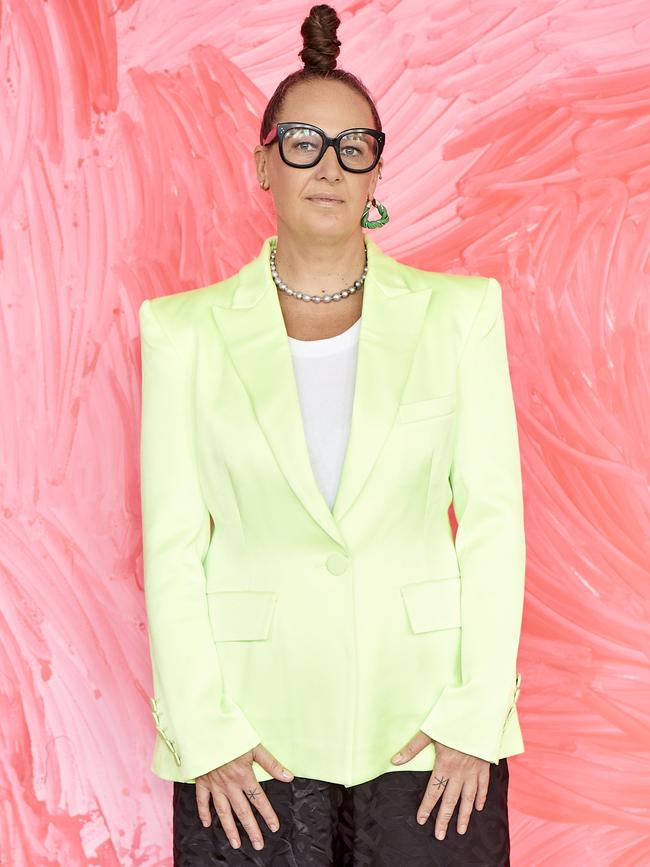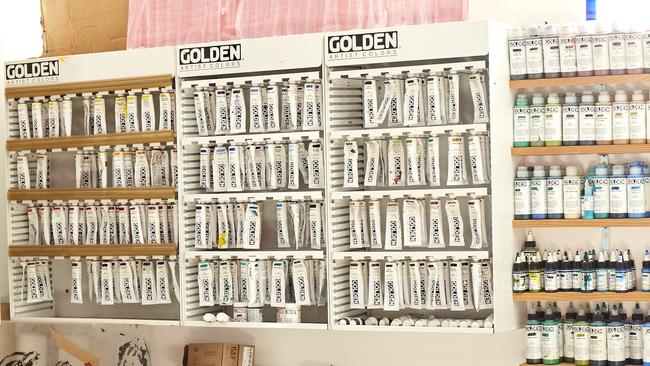Del Kathryn Barton’s Blaze shines a light on trauma
Acclaimed artist Del Kathryn Barton’s first feature film is a searing portrait of trauma that’s also very personal.

Del Kathryn Barton’s first feature film, Blaze, has standout central performances from 14-year-old newcomer Julia Savage and from Simon Baker as her onscreen father.
But the character who almost steals the show is a 4m dragon with a long sweeping tail, a seahorse-like snout and the most gorgeous eyelashes you’ve ever seen.
Blaze is the name of Savage’s character and Zephyr is her dragon – an imaginary friend who helps her negotiate a frightening episode in her young life.
The dragon has been so lovingly crafted by Barton and her small team of assistants – using luxe Italian fabrics, Swarovski crystals and other finery – that he’s virtually a piece of haute couture.
“It took about eight months, very labour-intensive work,” Barton says. “I wanted the puppet to be unapologetically handmade, like an art object, using all the best materials. I worked with my three studio assistants. Insanity.”

Barton, of course, is better known as a fine artist and especially as a painter of portraits whose surfaces are highly decorated and almost jewel like.
She has won the Archibald Prize twice – for a self-portrait with her two children, and again for a portrait of actor Hugo Weaving. Blaze is her first full-length feature film and it does not take long to discover that making it has been an intensely personal project.
The imagery of dragons stems from her childhood and a TV animated film she adored featuring Puff the Magic Dragon (more about strings and sealing-wax, in those days, than Swarovski sparklers).
Dragons also turn up in a five-panel painting called Sing Blood Wings Sing, made for Barton’s first major mid-career survey at the National Gallery of Victoria in 2017.
In this imaginary world, dragons represent female agency, the power inherent in a woman’s reproductive body, as well as the generative life-force of the creative imagination.
The inciting moment in Blaze also has personal resonance for the filmmaker. In the harrowing opening minutes, Blaze witnesses a violent rape after which the woman is left for dead. The story of the film is about how Blaze comes to terms – sometimes with Zephyr’s help, sometimes not – with the trauma she has experienced.

She becomes a tiny cog in the engine of criminal justice as she prepares to give evidence in court as a witness for the prosecution. Barton says she is a survivor of sexual violence, and has also witnessed an assault.
“I’m a survivor myself, and certainly that experience has informed my whole life in manifold ways,” she says. She refers to the shameful statistic that a woman in Australia is murdered every week, on average, by a current or former partner. Hearing that reported on the news a few years ago strengthened her resolve to tell a story about violence against women, but also about female empowerment.
“I was driving to my studio when I heard that,” Barton says. “My blood ran cold, tears came to my eyes; I was very triggered on a personal level. At that point I just felt a more cemented commitment to push that project to the forefront of my film-craft practice … “I’m very passionate about women telling women’s stories,” she adds. “I took that as a huge responsibility. It also came at huge personal cost, too.”
With its blend of naturalism, make-believe and surrealism, Blaze is an unusual film. Barton was adamant that she wanted to set the action in the recognisable environs of Sydney’s Paddington, where she has her studio, because it was “very important that I tell this story in the world I live in”.

The surrealist elements, including a tiny stop-motion puppet of Blaze, have echoes of another influence from Barton’s childhood, the short animations made by Czechoslovakian filmmaker Jan Svankmajer in the 1960s and ’70s.
It’s interesting that Barton uses the term film-craft when referring to her screen work, as she regards it as an extension of her fine-art practice, not separate from it.
Blaze is her first feature, although she has previously made an animated short, based on Oscar Wilde’s fable The Nightingale and the Rose. An introvert by nature, Barton is happier when busy in the studio, or behind the camera, than fronting up for opening nights. Still, she’s gratified by the response Blaze received at its premiere screenings at the Tribeca Film Festival in New York and then at the Sydney Film Festival in June.
Strangers, men and women, wanted to hug her.
“For me that is everything, and it’s all I really need as an outcome from this project – that people have approached me saying, ‘Thank you for not shying away from the reality of the violence’,” Barton says. “I feel like my whole oeuvre, with my painting and drawing practice, also speaks to that, but in a more removed, intangible way. This is much more pointy-end, and much more about storytelling.”



To join the conversation, please log in. Don't have an account? Register
Join the conversation, you are commenting as Logout